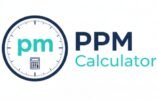1. What does PPM mean?
PPM stands for Parts Per Million. It measures the concentration of one substance within another — typically how much of a solute (like a chemical or mineral) exists in a million parts of a solution.
2. How is PPM calculated?
You can calculate PPM using the formula:
[ PPM = Mass of Solute (mg) / Volume of Solution (L)]
In simple terms: 1 mg of a substance in 1 liter of water = 1 PPM.
3. What is a PPM calculator used for?
A PPM calculator helps convert between mass, volume, and concentration — saving time and reducing errors in labs, hydroponics, water treatment, and industry.
4. What industries commonly use PPM measurements?
PPM is widely used in:
- Water quality testing
- Hydroponics and agriculture
- Environmental monitoring
- Industrial chemical processing
- Pharmaceutical and food production
5. How accurate are PPMCalculator.com’s tools?
All our calculators use verified formulas and are regularly tested against scientific standards.
However, real-world conditions (temperature, purity, calibration) can affect accuracy, so always double-check critical results.
6. Can I use PPM calculators for professional or laboratory work?
Our tools are designed for educational and research support.
For certified laboratory or compliance work, always use approved instruments or professional testing equipment.
7. What is the difference between PPM and mg/L?
In water-based solutions, 1 PPM = 1 mg/L.
They’re often used interchangeably — but mg/L specifically refers to the mass of solute per liter of solution.
8. What is the difference between PPM and PPB?
PPB (Parts Per Billion) is a smaller unit of concentration.
1 PPM = 1,000 PPB.
So PPB measures even smaller quantities of a substance in a solution.
9. How do I convert EC (Electrical Conductivity) to PPM?
You can use our EC to PPM Calculator.
It multiplies the EC value (in µS/cm) by a conversion factor (commonly 0.5, 0.64, or 0.7 depending on your meter type).
10. How do I convert TDS (Total Dissolved Solids) to PPM?
In most cases, TDS (mg/L) is numerically equal to PPM.
For instance, 200 mg/L ≈ 200 PPM.
You can verify this using our TDS to PPM Calculator.
11. What PPM level is safe for drinking water?
According to the World Health Organization (WHO), drinking water should generally have TDS below 300 PPM for best taste and quality.
Values above 1,000 PPM are typically considered unsafe.
12. What is a good PPM range for hydroponics?
The ideal range depends on the plant type and growth stage:
- Seedlings: 300–400 PPM
- Vegetative stage: 600–800 PPM
- Flowering stage: 800–1,200 PPM
Always follow your nutrient manufacturer’s recommendations.
13. Can PPM values be converted to percentage (%)?
Yes. 1% = 10,000 PPM. So to convert PPM to percent: divide the PPM value by 10,000.
14. What does “mg/L to PPM” mean?
It’s simply converting milligrams per liter (mg/L) to parts per million (PPM).
For water-based solutions, they’re equivalent: 1 mg/L = 1 PPM.
15. What is the formula to convert PPM to molarity?
To convert PPM to molarity (mol/L):
[ M = PPM / Molar Mass* 1000 ]
You can use our Molarity Calculator for precise conversions.
16. Does temperature affect PPM measurements?
Yes. Higher temperatures can change water density and conductivity, which may slightly affect PPM readings — especially in EC-based conversions.
17. Can I use your calculators offline?
Currently, our tools require an internet connection to function (browser-based).
However, we are planning to release offline or mobile-friendly versions in the future.
18. Are the calculators free to use?
Yes — all tools and converters on PPMCalculator.com are completely free for personal, academic, and educational purposes.
19. Can I share your calculators on my website or in class materials?
You can reference or link to our calculators (with credit), but embedding or copying them directly is not permitted without written permission. See our Copyright Policy.
20. How can I contact PPMCalculator.com for questions or feedback?
You can reach us anytime at:
📧 support@ppmcalculator.com or via our Contact Page.
